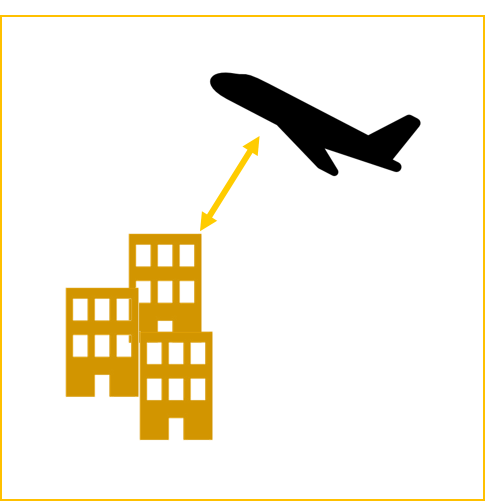Ensuring safe, secure, efficient and sustainable operations at airports of all levels is the most important element. To do so, many national and international regulations and standards must be met, predominantly based on ICAO’s International Standards And Recommended Practices (SARP).
As a consequence, SARPs in Annex 14 recommend Obstacle Limitation Surfaces (OLS) around airports to secure safety of the operation. Due to the development of high-rise buildings, wind turbines and other large objects in the vicinity of an airport, penetration of these surfaces is likely. Through a safety assessment we asses the influence of the object on the safety of the operation.
Aviation safety is a dynamic process. New safety hazards and risks continuously emerge. We systematically analyse, asses and mitigate. Hence an acceptable level of safety will be reached. If needed, innovative mitigation measures are implemented.
Aviation and regulation are inseparable. Our knowledge and expertise on aviation legislation assists federal governments, local governments and airports. The legislation is progressing over time, which is why we conduct continuous research to keep our knowledge up-to-date.
| Questions? Please feel free to get in touch! | Tel: +31 (0)85 – 00 711 00 | Mail: info@airinfra.eu |
Obstacle Limitation Surfaces (OLS) are in effect in the vicinity of airports, as are Building Restricted Areas (BRA) around the communication, navigation and surveillance (CNS) facilities. High obstacles in the surroundings such as wind turbines, the ATC tower, hangar(s), buildings or pylons, can interfere with these surfaces. Obstacles lower than these surfaces are allowed. However, penetrating obstacles may be allowed in certain situations or locations. Are you wondering about your situation? We can conduct height assessments of these objects in respect to the surfaces and analyse risks with infringements.
The International Civil Aviation Organisation (ICAO) Annex 14 comprises SARPs that prescribe the physical and operational characteristics for aerodromes (volume I) and heliports (volume II). In the European Union, volume 1 has been put into effect by EASA (CS-ADR-DSN Aerodromes Design) and we have been strengthening our expertise in aerodrome design ever since. We can assist your airport and surroundings becoming compliant with the aerodrome design requirements conform the required standards.
Hazards and their aftermath can be determined through hazard identification. To do so, an analysis is required assessing the probability of the hazard effects and the severity of these effects on the aircraft operations. We use the SARPs from ICAO’s Doc 9859 Safety Management Manual as a guideline. Based on this document, we analyse the probability and whether the risks are negligible or catastrophic and decide whether these risks are acceptable or unacceptable. The next step would be to research and develop effective mitigations, or in other words: safety management.
All aerodromes are required to have a Safety Management System in their organisation focussing on research and developing effective mitigations in order to minimise risks. Our expertise is the support and advice in the implementation. Key elements are: Plan, Do, Check, Review. The necessity for these key elements to work, is maintaining a periodical review. Are you interested in how we can assist? Please contact us, we are happy to help.
The regulation and legislation of aviation activities are important at both national and international level. In principle, the international regulations are predominantly based on the SARPs of ICAO. On European level these regulations have been implemented by the European Commission (EC) and need te be adopted in national legislation. All these legislations can be hard to understand and implementation is difficult. Therefore we advice governments and local governments on how they can implement the aviation legislation in their policy. Additionally, we keep an eye on future developments, including drones and UAVs, to implement these in a safe and sustainable manner.
